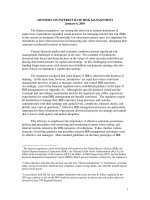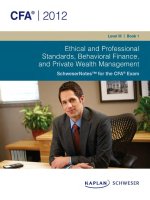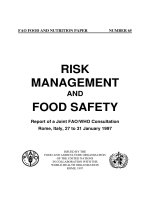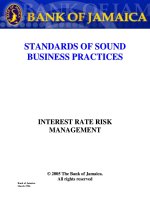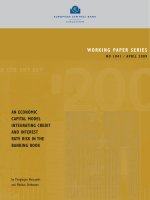Trade Finance and Exchange rate Risk Management
Bạn đang xem bản rút gọn của tài liệu. Xem và tải ngay bản đầy đủ của tài liệu tại đây (456.79 KB, 14 trang )
Credit management for exporting firm
• Short term trade finance is provided and repaid within 2 years
• Covers purchase and sale of consumer goods
Trade cycle and Operating cycle?
- Trade cycle: the time period bw the start of supply chain (ordering good
and raw materials and receipt of payment for corresponding sales of
finished products)
- Business use working capital to finance the trade cycle
- Operating cycle: Operating cycle is the time period between the acquisition
of inventory and when cash is collected from receivables
Operating cycle = average days sales in inventory + the average collection period
Cash Conversion Cycle = Inventory conversion period + Receivables
conversion period - Payables deferral period
Cash Flow Time Line
Operating and Cash Conversion Cycles
Cash
received
Inventory
sold
Inventory
purchased
Inventory period
Accounts receivable period
Time
Accounts payable period
Cash paid for
inventory
Operating cycle (OC)
Cash Conversion Cycle (CCC)
Financing of international trade
Trade Credit -- credit granted from one
business to another
Credit management for exporting company
Trade financing:
Bank’s acceptance
Negotiating financing
Factoring/forfeiting
Batter/ countertrade
Compensation…..
Trade credit
– Open Accounts: the seller ships goods to the buyer
with an invoice specifying goods shipped, total
amount due, and terms of the sale.
– Notes Payable: the buyer signs a note that evidences
a debt to the seller.
– Trade Acceptances: the seller draws a draft
(B/E) on the buyer that orders the buyer to pay
the draft at some future time period.
– Net Period - No Cash Discount -- when credit is
extended, the seller specifies the period of time
allowed for payment. “Net 30” implies full payment
in 30 days from the invoice date.
Trade credit
• Net Period - Cash Discount -- when credit is extended,
the seller specifies the period of time allowed for
payment and offers a cash discount if paid in the early
part of the period.
• An example would be “3/10 net 30”
– The customer can take a 3% discount if he pays
within 10 days.
– In any event, he must pay within 30 days.
The Interest Rate Implicit in 3/10 net 30
A firm offering credit terms of 3/10 net 30 is essentially
offering their customers a 20-day loan.
To see this, consider a firm that makes a $1,000 sale on day 0
Some customers will pay on day 10 and take the
discount.
$970
0
10
30
Other customers will pay on day 30 and forgo the
discount.
$1,000
0
10
30
A customer that forgoes the 3% discount to pay on day
30 is borrowing $970 for 20 days and paying $30
interest:
-$1,000
+$970
0
10
$970
r
30
$1,000
(1 r ) 20 365
$1,000
$970
365
20
(1 r ) 20 365
$1,000
$970
1 0.7435 74.35%
The Decision to Grant Credit: Risk and
Information
• Consider a firm that is choosing between two
alternative credit policies:
– “In God we trust—everybody else pays cash.”
– Offering their customers credit.
• The only cash flow of the first strategyQ0 ( P0 C0 )
is
• The expected cash flows of the credit strategy
are: ’ ’
h Q0’ P0’
C0 Q0
0
We incur costs
up front…
1
…and get paid in 1
period by h% of our
customers.
Example of the Decision to Grant Credit
• A firm currently sells 1,000 items per month
on a cash basis for $500 each.
• If they offered terms net 30, the marketing
department believes that they could sell 1,300
items per month.
• The collections department estimates that 5%
of credit customers will default.
• The cost of capital is 10% per annum.
Example of the Decision to Grant Credit
No Credit
1.000
$500
$400
100%
0
Quantity sold
Selling price
Unit cost
Probability of payment
Credit period (days)
Discount rate p.a.
The NPV of cash only:
1,000 ($500 $ 400)
Net 45
1.300
$500
$425
95%
30
10%
$ 100,000
The NPV of Net 30:
1,300 $425
1,300 $500 0.95
(1.10)30 / 365
$60,181.58
Bershire Sport, Incs., operates a mail-order running shoe business. Management is
considering dropping its policy of no credit. The credit policy under consideration by
Bershire follows:
unit price
cost per unit
quantity sold
probability payment
credit period
discount rate
No credit
$45
$35
2000
100%
0
0%
credit
$50
$42
3000
95%
1
2%
Example of the Decision to Grant Credit
• How high must the credit price be to make it
worthwhile for the firm to extend credit?
The NPV of Net 30 must be at least as big
as the NPV of cash only:
$100,000
1,300 $425
1,300 P0’ 0.95
(1.10) 30 / 365
($100,000 1,300 $425) (1.10)30 / 365 1,300 P0’ 0.95
P0’
($100,000 1,300 $425) (1.10) 30 / 365
1,300 0.95
$532.50
Bank’s acceptance (BA)
• This is time darft that is drawn on and accepted by a bank
(importer’s bank). The accepting bank is obliged to pay the
holder of the draft at maturity
• If exporter does not want to wait to payment, it can request
that BA be sold in the money market. Trade financing is
provided by the holder of the BA
• The bank accepting the draft charges an all in rate (interest
rate) that consists of the discount rate plus acceptance
commission
• In general, all in rates are lower than bank loan rates.
Trade financing – Bank’s acceptance
• Bank’s acceptance: Financing for exporter base on time Draft
(time B/E)
Example:
B/E issued by exporter with face value $100,000 for 90days
Bank’s acceptance commission: 1.5% /annum
Discount rate for 90days: 1.14%/annum
Scenario 1: Exporter hold draft until maturity and then
collect money:
Face value of the acceptance: $100,000
Less 1.5% per annum commission for 90days =
0.015*3/12*$100,000 = 375
Amount received by exporter in 90days (three months) =
$99,625
Trade finance – Banker’s acceptance
Scenario 2: Exporter may ‘discount’ with its bank in order to
receive funds at once
Face value of the acceptance: $100,000
Less 1.5% per annum commission for 90days =
0.015*3/12*$100,000 = 375
Less 1.14% per annum discount rate for 90days =
0.0114*3/12*100,000 = 285
Amount received by exporter in 90days (three months) =
100,000 - 375 - 285 = $99,340
Therefore, the all in cost of finance this banker’s acceptance is:
(commission+discount)/proceeds x (360/90) = (375+285)/99,340
x (360/90) = 0.266 or 2.66%
Example 2
Assume the time from acceptance to maturity on
a $2,000,000 banker’s acceptance is 90 days.
Further assume that the importing bank’s
acceptance commission is 1.25 percent and that
the market rate for 90- day B/As is 7 percent.
Determine the amount the exporter will receive if
he holds the B/A until maturity and also the
amount the exporter will receive if he discounts
the B/A with the importer’s bank.
Exercise
The time from acceptance to maturity on a $1,000,000
banker’s acceptance is 120 days.
The importer’s bank’s
acceptance commission is 1.75 % and the market rate for
120-day B/As is 5.75 %
1. What amount will the exporter receive if he holds the B/A
until maturity?
2. If he discounts the B/A with the importer’s bank? Also
determine the bond equivalent yield the importer’s bank will
earn from discounting the B/A with the exporter.
3. If the exporter’s opportunity cost of capital is 11 %, should he
discount the B/A or hold it to maturity?
Exercises
Q1: Jackson Automotive Inc. of California agrees to sell specialized automotive
parts to Hidatsi of Korea. Because the two companies have never done business
with each other, Jackson requires a banker’s acceptance as payment for the
$1,000,000 order. The banker’s acceptance carries a 1.4% commission per
annum and payment is to be received in 6 months. If Jackson Inc. chooses to
discount or sell the bankers acceptance to its bank, the discount rate is 1.00%
per annum.
1. What is the size of the commission Jackson Automotive will pay the bank for
the banker’s acceptance?
2. What is the total Jackson Automotive can expect to receive if the firm takes
payment today?
3. What is the size of the discount (not including the commission fee) Jackson must
take for receiving the proceeds of the sale today rather than waiting for six
months?
Q2. Custom Granite Inc. has a Canadian receivables contract for $200,000 due in
270 days. The firm has been approached by a factoring firm that offers to
purchase the receivables at a 12% per annum discount plus a 1% charge for a
nonrecourse clause. What is the annualized percentage all-in-cost of this
factoring alternative?
Trade finance – Factoring
- Factor purchase receivable at discount on either a non-recourse or
recourse basic
- Non-recourse: factor assumes the credit, political and forex risk
of receivables it purchase
- Recourse: factor can give back receivable that are not collectable
- All in cost of factoring non-recourse receivables is similar
structure acceptances. The factor charges commission cover the
non-recourse risk + interest as discount rate
- Example:
US company wishes to factor its receivable it face amount 5,000,000
USD for 3 month, non-recourse fee 1.5% and factoring fee
(2.5%/,month x 3month)
Net proceed on sale (US company receives now) = 5,000,000 –
75,000- 375,000 = 4,550,000 USD (91% of face value receivable)
Trade finance – Alternatives
- Securitization: The securitization of export receivable for
financing trade by selling them to a legal entity established to
create marketable securities based on package of individual
export receivable from exporter’s balance sheet because they
have been sold without recourse
- Bank credit line covered by Export Credit Insurance
- Forfaiting: Medium and long-term financing
+ using to eliminate the risk of non-payment by importers in
instances where the importing firm and or its government is
perceived by the exporter to be too risky for open-account
credit
Demand of Guarantees (L/G)
Rule for guarantee:
URDG 758, ICC, 2010
For bank’s perspective the most important articles:
-Art 8: content of instruction and guarantees
- Art: 10: Advising of a guarantees or amendment
- Art 11: Amendment
- Art 14: presentation and Art 19: examination
- Art: time for examination of demand and payment: 5 days following the
day of presentation
- Art 23: extend or pay: in the event of a complying demand being presente
the guarantor is now faced with two choices:
+ pay immediately
+ suspend payment for a sprecified period
Art 24: Non- complying demand, waiver and notice
.
Check for Guarantees
1. The ICC guidelines for guarantees is:
UCP 600
URDG 758
URC 522
Incoterms 2010
2. Company A contracts to build a bridge for Company B. Company A asks its
bank to issue a bond company A is known as the:
a. Applicant
b. Beneficiary
c. Guarantor
d. Issuer
Stand-by LC
• Rules:
ISP 98 and UCP 600 ( as stated in Art 1-UCP 600)
- Standby LC is used to protect against non-performance BUT NOT a primary
means of making a payment
Typical uses include:
- As a type of guarantee that a loan will be repaid
- As a back up guarantee that buyer/importer will meet some other preagreed payment obligation such a settlement of a sight B/E attached to a
collection or open account
- The situation outline in the introduction where protection against a failure
to perform a contracts is required
….
Stand-by LC
ISP 98 rules for standby:
- Irrevocable: 1.06b
- Enforceable: 1.06c
- For payment against documents: 1.06d
- Limited as to the issuer’s responsibility: 1.08
- Undertaking: 2.01/2.05
- Capable of amendment: 3.09
-
ISP 98 also contains rules in the event of dis-honour (5.01), notice of which
must be timely – more than 7 days being unreasonable
STANBY can transfer. ISP 98 DIFFER WITH UCP 600: they may not be
partially transferred but may be transferred more than once (6.02)
A comparision bw standby LCs AND demand of guarantees
Foreign Exchange Risk Management
Nikken has sold Internet servers to TE company for EUR
700,000. Payment in due in three months and will be made
with bank’s acceptance commission 1% per annum of the face
value and discount rate 4%/annum.
1. What is the annualized percentage all-in cost in EUR of this
method of trade financing?
2. Assume that Nikken prefers to receive USD rather than EUR
for trade transaction. It is considering two alternatives:
(1) Sell the acceptance for EUR at once and covert the EUR
immediately to USD at spot rate: $1/EUR
(2) Hold the EUR acceptance until maturity but at the start sell
the expected EUR proceeds forward for USD 3months
forward rate $1.02/EUR
Question:
a. What are the USD net proceeds received at once from the
discounted trade acceptance in alternative 1?
b. What are the USD net proceeds received in 3 months in
alternative 2?
c. Which alternative should Nikken choose?

